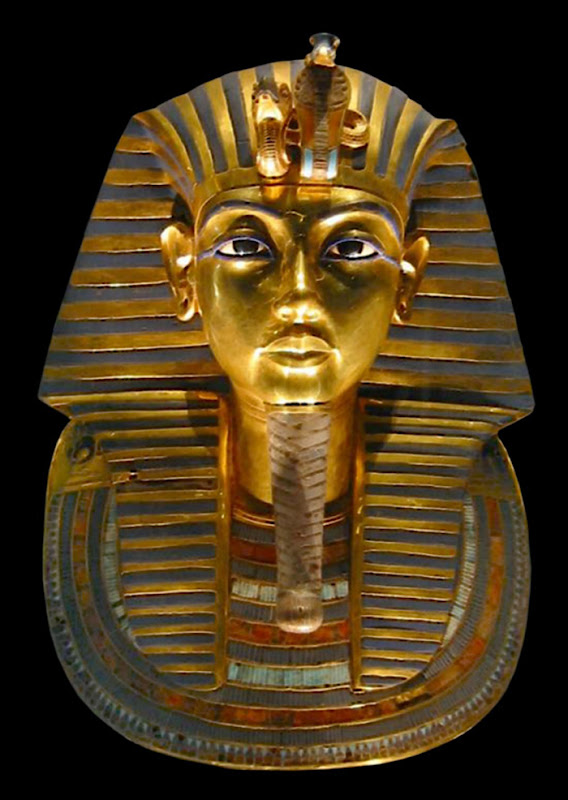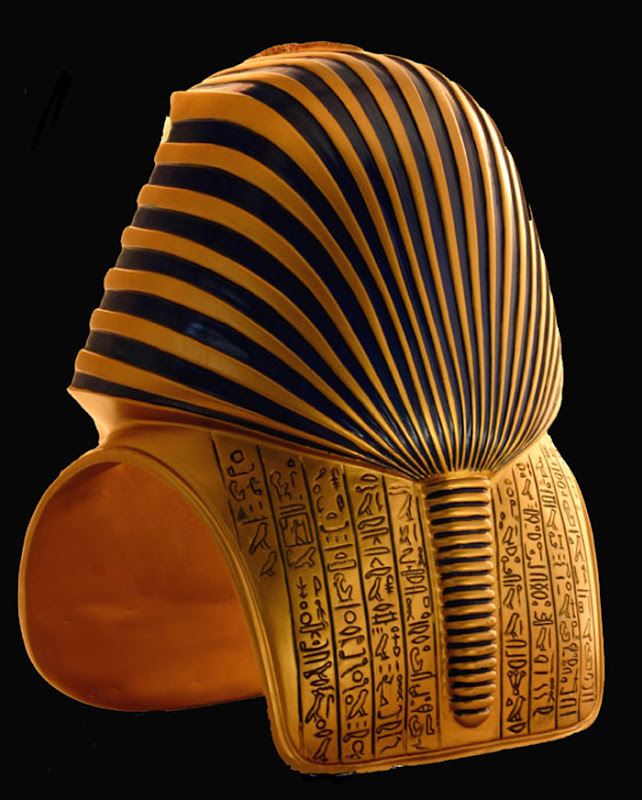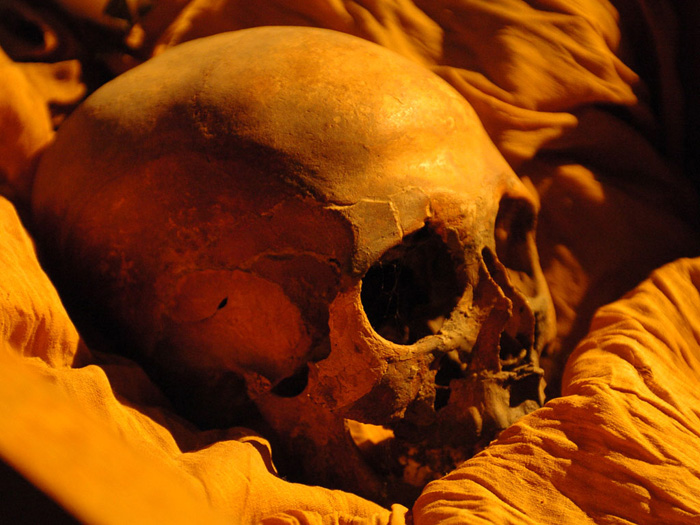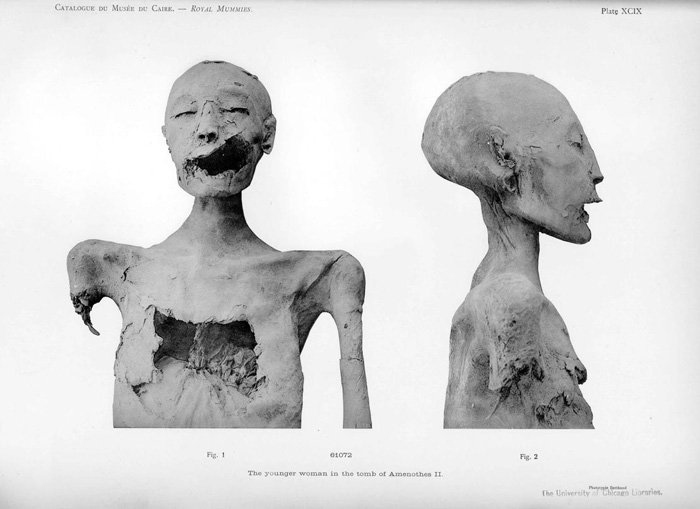
mask of gold and semiprecious stones of the mummy of Tutankhamun (Cairo Museum)
... I know that some people find it disgusting ... Yet you can not imagine that the publication of that report, so far only published in English in the journal Journal of American Medical Association , really enjoy the extreme ... In a word, I licks the last few days reading all I can find on the subject, to the detriment of more important work I have to do ... Ecce Ogro!
Below is an article from one of the many magazines and many newspapers to have published on the subject and signed by Jean-Luc Goudet . Posted here and slightly increased by a number of details found elsewhere, or in my own library ... (Which the author wants to forgive me ... others will see the main source of this article ...) ... I have shown with what I found in my cupboards ... And then, I promise, I do not make you too long ... Faith is not a custom (Jacques Prévert) ...

mask of gold and semiprecious stones of the mummy of Tutankhamun (Cairo Museum)
The genetic analysis are discussed. Tutankhamun was not the son of Nefertiti.
It would be the result of incestuous love of Akhenaten, the pharaoh, and a sister. As for the early death of the young pharaoh, she would be due to malaria and without may have been precipitated by some genetic defect.

head of the mummy of Tutankhamen
The ineffable Dr. Zahi Hawass the man in the Stetson screwed on head to the image of Indiana Jones, his hero, told the world press this Wednesday, February 17 at the Cairo museum, the results of genetic analysis conducted on several mummies, including that of Tutankhamun.
The study, conducted by teams of Faculty of Medicine of Cairo, the Egyptian National Research Centre, University of Tübingen (Germany) and Eurac (Italy), has just been published in the Journal of the American Medical Association . It sheds new light on the strange fate and if short of the Pharaoh Tutankhamun, also indicating the affiliations of the royal family over five generations.

Jewel of the royal treasury. Tomb of Tutankhamen
Historians, Tutankhamun is the son of Amenhophis IV (or Amenhotep IV) and his wife Nefertiti. [...] This reduces the original Pharaoh the power of priests and established the cult of Aten, the solar disk, the point of changing its name to Akhenaten, "he who pleases Aton".
At his death, the religious power has its revenge and restore the orthodox beliefs, in which the god Amun (the god "hidden" ... and therefore the opposite of the god that is visible to all Aton ...) takes a principal role.
The very young pharaoh, age 9, Tutankhaton is rechristened and named Tutankhamun. Died very young (19 years), he was buried with pomp, as evidenced by his famous mummy richly adorned.

Jewel of the royal treasury. Tomb of Tutankhamen
In 2005, Zahi Hawass and his team began a series of studies on the mummy. A CT scan analysis (or positron) reversed the hypothesis of murder, based on the presence of a hole in the skull (which would have been charged at the time of mummification). Today, DNA analysis tells us much about the young pharaoh of the 18th dynasty, who lived in the 14th century BC. AD.
In language Egyptologist, DNA is the son of Tutankhamun KV55 and KV35YL. Plain language of Akhenaten and the Young Lady. The mummy found in tomb KV55 numbered effect is attributed to the fourth pharaoh Amenhotep (Akhenaten alias ...). As for the KV35YL mummy, nicknamed "Young Lady" (Young Lady), it was thought previously that it was none other than the beautiful Nefertiti. But she also underwent genetic testing and its DNA shows that she was the sister of Akhenaten. Moreover, genetic studies also indicate that Akhenaten was the son of Amenhotep III and Tiy, as the Young Lady's tomb KV35YL, which may not be Nefertiti, Zahi Hawass concluded.

Skull KV55 mummy (Akhenaten ...)

Remains of the mummy KV35YL (Young Lady ...), sister Akhenaten and Tutankhamun's mother

Remains of the mummy KV35YL (Young Lady ...), sister of Akhenaten and Tutankhamun's mother
Tutankhamen is well legitimate son of his father (some Egyptologists were by his brother) but not the wife of his father. His mother was the sister of his father ... Incest was customary in the royal lineages of ancient Egypt and the fact is not surprising. Tutankhamun has also been married to Ankhesenpaamon (nee Ankhesenpaaton), daughter of Akhenaten and Nefertiti and therefore his half-sister ...
Other mummies studied, those of Yuya and Tuya, would, respectively, the father and mother Tiye and therefore the grandparents of Akhenaton. The mystery remains, however, for two fetuses found in the tomb of Tutankhamun. It would be the father, says the DNA, but their mother remains unknown.

KV35OL Mummy (Old Lady ...), Queen Tiy, wife an era Royal Amenothep III, Akhenaten's mother and grandmother of Tutankhamun

KV35OL Mummy (Old Lady ...), Queen Tiy, wife an era Royal Amenothep III, Akhenaten's mother and grandmother Tutankhamun

mummy fetuses found in Tut's tomb
DNA test results also indicate the causes of premature death of Tutankhamen. Many theories have circulated, the latest being that of gangrene after a meteoric drop tank. The researchers identified the genes of a parasite known Plasmodium falciparum malaria agent (or malaria). The disease was also detected in three other family members. Tutankhamen's parents have also bequeathed him a few flaws, including disease Köhler necrosis of bone that deforms the foot pain and generates painful (hence, presumably, the presence of numerous rods found in the tomb of the latter ...)

family tree, resulting from recent studies on the Amarna family ...

Jewel of the royal treasury. Tomb of Tutankhamen
Another theory is refuted, that of Marfan syndrome, which could explain the physical, surprisingly rangy, representations of the royal family, simply idealized by artists who followed the fashion of the time, making the figure of a pharaoh worship.

Mummy of Tutankhamun
With malaria, birth defects and bone necrosis, Pharaoh ephemeral does not seem to have a great chance to live long. The young man found his revenge on destiny through the pomp its mummification, who is a celebrity 34 centuries later, when Howard Carter discovered his tomb in 1922.

Howard Carter (1874-1939) before the mummy of Tutankhamen in 1922
0 comments:
Post a Comment